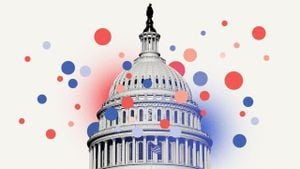The 2024 U.S. Senate elections, held on November 5, have shaped the political outlook of the country, returning Republicans to the majority and setting the stage for significant legislative changes over the next several years. Following election night, the GOP emerged victorious, claiming seats across several states, which has propelled their influence across both chambers of Congress.
With the final results still being tallied, Republicans are projected to hold 53 out of the 100 Senate seats. This number reflects strategic gains made primarily through competitive races across swing states, where Democratic incumbents were up for re-election, including key contests in West Virginia, Ohio, and Montana. The Democrats, on the other hand, now occupy 45 Senate seats, with some seats still waiting for confirmation.
Speaker of the House Mike Johnson, R-La., expressed confidence on election night, noting, “Republicans are poised to have unified government in the White House, Senate and House.” His predictions speak to the ambition of the GOP to move forward with their agenda, especially with Donald Trump at the helm, having secured the presidency with 295 out of 538 electoral votes.
Trump's electoral victory over Democratic Vice President Kamala Harris has reignited discussions around his agenda, which promises tax cuts, strict immigration measures, and significant regulatory rollbacks. “Trump is thinking big about his legacy,” Johnson stated, and preparations for the first 100 days of the new administration have begun. Expect tax reform, enhanced border security, and plans to significantly cut back on the federal workforce.
The election results have generated ripples through the Democratic Party, which is left grappling with the reality of losing both control of the Senate and their place within the White House. According to the Washington Post, the Democrats now hold 197 out of 435 seats, allowing Republicans to achieve their predicted majority with at least 209 seats. This shift signifies not just numbers but also ideological realignments with potential repercussions for legislation on health care, climate initiatives, and social policies.
With such significant changes on the horizon, experts are closely studying the ramifications of this power shift. Analysts argue it is not merely about the numbers but also about strategy and the messaging of the GOP, which has become more aligned with Trump’s MAGA movement. This transformation particularly highlights the party's efforts to mobilize both new and established powerhouses within the GOP.
Adding to the discussions around the election results are the logos of the new Congress, characterized by hard-liners and party members who often find themselves at odds with traditional Republican stances. Representatives like Marjorie Taylor Greene and others are part of the ensemble set to enforce their views upon the House leadership, creating what many regard as challenges to conventional governance.
Looking forward, Johnson anticipates significant legislative activities if the GOP-unified government is realized. The Republicans are preparing for measures such as “taking a blowtorch to federal regulations,” and focusing on pushing agencies out of Washington as part of their strategy to reshape federal governance.
Meanwhile, the national discourse has taken note of Trump’s promises for mass deportations and retribution against specific groups he perceives as opponents, signaling to many Americans the tone of the next phase of governance. Analysts warn such hard-line positions might mobilize counteractions from Democrats and independents, leading to deepening divisions within the electorate.
Electoral outcomes such as these also trigger discussions around upcoming 2026 elections, potentially reshaping America’s political battleground for the foreseeable future. For now, as votes continue to be counted and leadership roles are determined, the American political scene stands at yet another significant crossroads, with both parties reconsidering their positions and strategies as they adapt to this new reality.
For the GOP, the events following the 2024 elections highlight the consolidation of power under Donald Trump and his allies, which fundamentally alters the political playbook. Meanwhile, questions loom large for Democrats as they navigate their next moves amid perceived losses, aiming to build strategies to reclaim power.
Now the focus shifts to what Republicans will do with their newfound power. How the administration will leverage this moment remains to be seen, but the anticipation of upcoming changes hangs heavily over the Capitol. With Trump’s leadership and the party's backing, many eyes will stay glued to the developments as lawmakers prepare their first actions come January.
The 2024 Senate election results certainly held significant weight, and the next few months will be pivotal for both parties as they attempt to shape the legislative agenda and rally support from their constituents. With stakes as high as they are, American voters will undoubtedly be watching closely to see just how these changes will manifest at both the federal and local levels.



